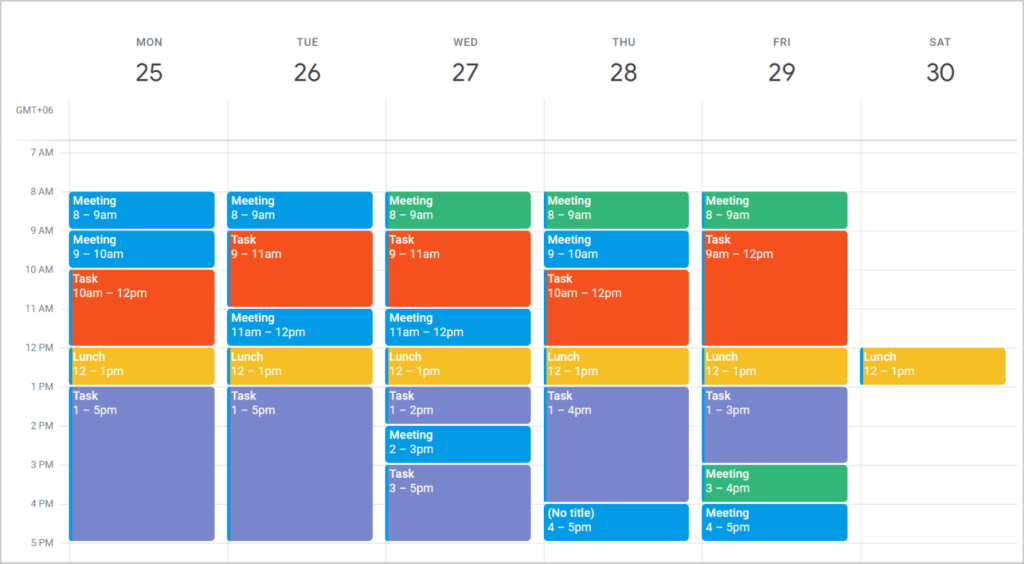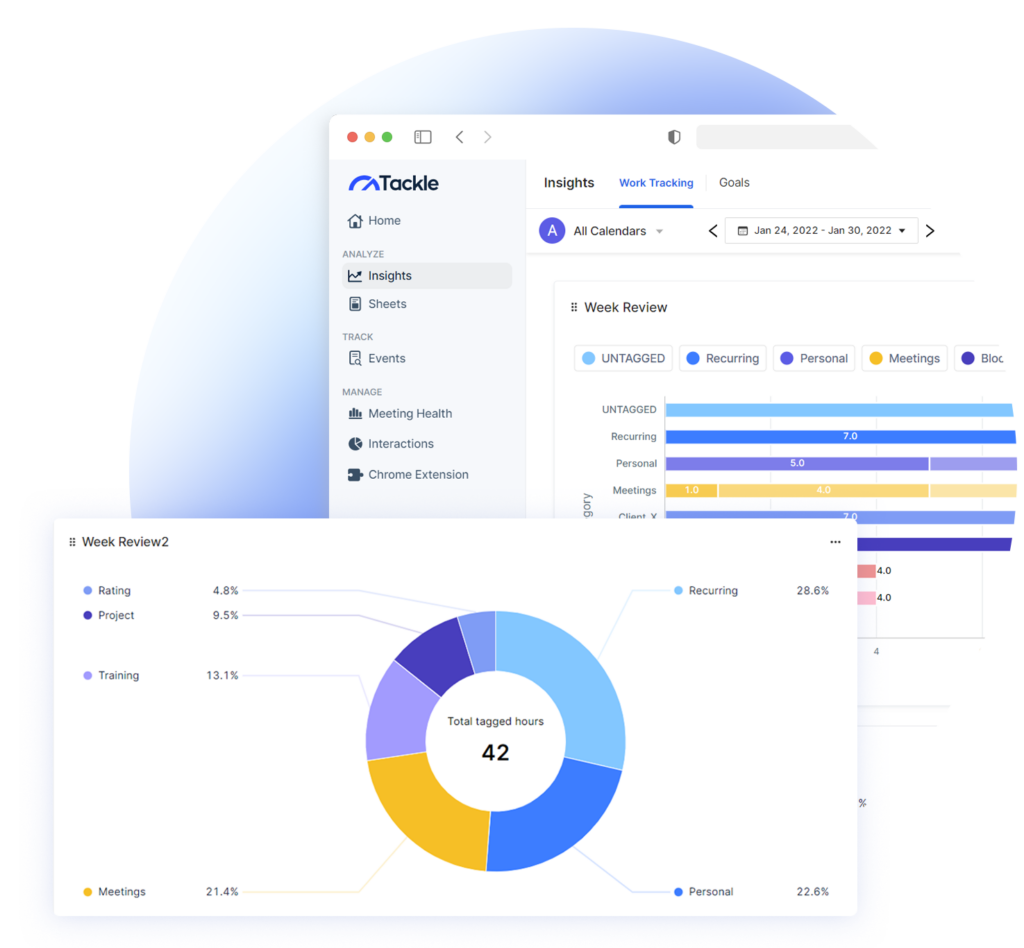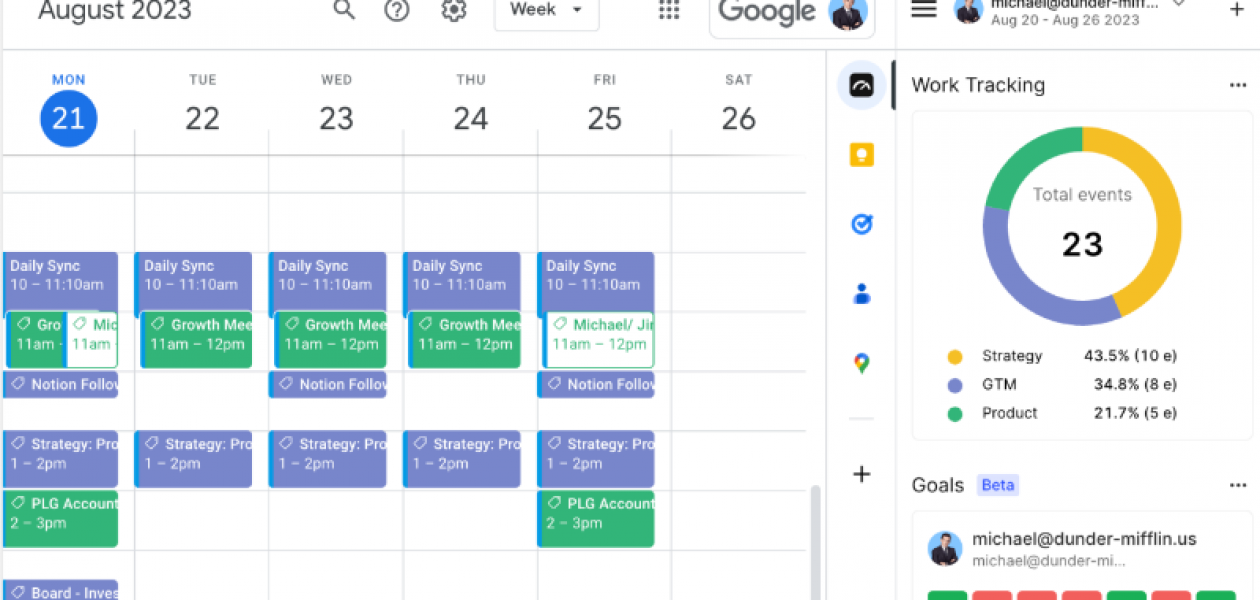In the corporate world, the CEO remains at the top of the hierarchy. Yes, they have a plethora of resources. But their most valuable resource is scarce. A CEO’s schedule involves the least time and the heaviest responsibilities on their shoulders. Managing where a CEO invests time and energy is crucial to organizational success, but it can be a challenging task.
Calendar management is more than dumping meeting dates on your schedule. It’s about tracking time and identifying principal matters. A Harvard Business Review study stated that CEOs find time management a significant hurdle. It shows how much founders are intimidated by their scheduling process. So, if you are a founder or a CEO struggling to arrange your meetings, go through the following handbook and get a headstart toward organizational success.
Just so you know, CEO time management isn’t easy but you got this!
Table of contents
Why CEOs need an effective schedule?
“If you wanted to underline one thing, I cannot emphasize enough — leadership requires energy, focus, and discipline. You can only have good habits, and they start with getting a decent night’s sleep and exercising.”
– Mike Steib, CEO of XO Group
Mike Steib mentions that a healthy schedule is key for CEOs. As the CEO of a large media company, he keeps a blueprint of his day from the moment he wakes up, including daily meetings, employee check-ins, and brainstorming sessions. Despite his busy schedule, he doesn’t compromise on his health. You need good habits to lead a healthy and stress-free life. But to build those habits, you need time. An effective schedule will always find time for you to rest, meditate, exercise, spend time with family, and so on. Like Mike, you need to have a calendar that maximizes your productivity.
An isolated and out-of-touch CEO who doesn’t spend enough time with coworkers may be perceived as a micromanager. Conversely, a micromanager who spends too much time in direct decision-making risks eroding employees’ initiative. Therefore, a CEO’s schedule, like that of any other top-level executive, is an expression of leadership and communication style.
How to optimize a CEO’s daily schedule?
Create a zero-based calendar. ⏰
Cathryn Lavery and Allen Brouwer, co-founders of BestSelf Co, promote the idea of a Zero-Based Calendar.

“Promoted by Cathryn Lavery and Allen Brouwer, co-founders of BestSelf Co, the Zero-Based Calendar is a time management system that requires you to account for every second of your day.”
– Calendar co-founder John Hall
Calendar co-founder John Hall explains that it’s a time management system that requires you to account for every second of your day.
You can achieve this calendar system with a few simple steps:
Step 1: Plan everything ahead of time, including your to-do lists, breaks, and gatherings.
Step 2: Determine the time you need to complete each task.
Step 3: Observe your schedule for a few days and identify how much time you spend on tasks you want to do. These estimates will help you set aside enough time for each activity.
Step 4: Take precautions and allow yourself a 50% buffer time.
Greg McKeown, author of Essentialism, suggests a simple rule. A 30-minute meeting requires an hour of planning. So, allocate an hour and use the first 15 minutes for preparation to avoid delays. You’ll have an extra 15 minutes at the end if the meeting runs beyond schedule.
Also, you can add a few “free” blocks to your calendar to set aside some room for flexibility and spontaneity.
Use a time tracking tool
The average CEO schedule has more than 35 meetings per week. So, allocation of time is important because time is a limited resource.

You can use Tackle to sync your calendar events with meeting agendas. Tackle helps you to track time and capture productivity insights.
You can categorize meetings and events according to priorities. Also, you will identify which activities take up most of your and your team’s time and whether these activities are important.
Run regular calendar audits 📆
In the realm of effective CEO time management and optimizing the daily CEO schedule, conducting a thorough calendar audit is pivotal. This process involves scrutinizing past schedules, recognizing patterns, and prioritizing tasks. Tools like Tackle play a significant role in this, providing insightful analytics into the CEO’s daily schedule. By leveraging Tackle for this essential task, CEOs gain valuable insights to refine their schedules, ensuring alignment with strategic objectives. Tackle’s analytics empower CEOs to make data-driven decisions, enhancing both their productivity and impact in managing their daily CEO schedule efficiently.
Aim for work-life Integration, not just work-life balance
Stephen Kohler, CEO, and creator of Audira Labs explained work-life balance and work-life integration as
“While work-life balance emphasizes keeping your professional and personal lives separate but equal, work-life integration is based on the concept that there is no separation between the two and that they must coexist in harmony.”
Work-life balance aims to establish an ideal situation in which work and life coexist and thrive separately; work-life integration focuses on integrating your work and life together as one.
Professionals who integrate their professional and personal lives take less notice of what defines “work time” and “personal time” and instead focus on the optimal time to accomplish these tasks. This may be working later in the day in order to concentrate on a personal project in the morning, or checking email after hours but also checking and replying to personal email during the workday.
In other words, work-life integration views all of your daily activities collectively and is less concerned with compartmentalization.
To know more about work-life integration check out our article on Work-life balance vs work-life intregration.
Build playbooks 📚
As CEOs, your job is grueling. You need to juggle your time among shareholders and clients. Your breaks aren’t typical rest periods, as you have to assist others in their personal development.
You have a lot on your plate, and the usual response is to compromise personal priorities and health. But this is a temporary solution, which increases anxiety and stress levels.
A better response is to delegate responsibilities to avoid burnout and clean up your CEO schedule.
Go through your list and identify activities that consume most of your time and energy. Which of these tasks do not require your attention? Find out the answer and start assigning these tasks to other people.
Your managers can handle day-to-day operations such as staff meetings or assessments. It will not only save time but clarify roles within your organization. So you will have more time and energy to focus on the big picture.
Documenting your methods and expectations is always a good idea. So, make a playbook and stick to it.
Be proactive, not reactive 💢
Peter Drucker, the modern business management guru, said,
“Efficiency is doing things right; effectiveness is doing the right things.”
A leader has to do the right things. When you become CEO, everyone will approach you for help. Especially in startups, it is easier to approach the CEOs. So, you are responding to problems and battling fires. Everyone views you as a great problem-solver.
Remember that the higher your position in the organizational hierarchy, the more problems you face. The fun part is that you have more resources at your disposal.

But when you are always busy dissolving fires, it becomes impossible to manage your calendar. So, be a chess player like Magnus Carlsen. Instead of reacting to people’s moves, anticipate them and plan your move.
Parting advice
This handbook will help you whether you are a new CEO or a seasoned veteran. To create an efficient calendar, you need clear communication.
“How do you make sure that you’re not drinking your own Kool-Aid too much, and that you’re being appropriately self-critical with how you spend your time.” – Sam Hodges, Co-Founder and Managing Director of Funding Circle U.S.
When you are the CEO, people may hesitate to say things you should hear. Hence, you should aim to create an open and transparent culture.
CEO schedule is more difficult because the job size and scope have expanded. Increased diversity and competition demand more accountability from you.
But the upside is now you don’t rely on pens and paper. You have cutting-edge technologies and software at your disposal. Make the best use of them to become a pro at time management.
Summary
“Because you are a leader, people are nice to you and don’t necessarily tell you everything that you should be hearing. I think that’s one of the reasons why you want to create a really open and transparent culture. In some cases, I’ve seen leaders be willfully ignorant, and in other cases, I’ve seen leaders just not get all the information they need and fail because of that.
“How do you make sure that you’re not drinking your own Kool-Aid too much, and that you’re being appropriately self-critical with how you spend your time.”
– Sam Hodges, Co-Founder and Managing Director of Funding Circle U.S.
Being a CEO has become more difficult as the job’s size and scope have expanded, organizational complexity has increased, technology has advanced, competition has increased, and CEO accountability has increased. In introducing these principles, we hope to provide current and future leaders, who must shoulder such a heavy burden, a better understanding of their role and how to make better use of their most valuable resource: time.
FAQ
How many hours a day do CEOs work?
Harvard Business Review recently delved into CEO schedule and time management, shedding light on their daily routines. In a study of 27 CEOs, including 2 women and 25 men, from high-revenue companies averaging $13.1 billion in annual revenue, activities were tracked in 15-minute intervals for three months. This comprehensive analysis provides valuable insights into how CEOs manage their time effectively, emphasizing the crucial aspect of CEO time management in their demanding roles.
The study revealed that CEOs worked an average of 9.7 hours per weekday, totaling 48.5 hours per workweek. They also devoted 79% of weekends, working approximately 3.9 hours daily, and 70% of vacation days, averaging 2.4 hours on those days. In contrast, the average American works 44 hours per week, with nearly a third working on weekends, according to the Bureau of Labor Statistics.
Which should a CEO focus his time on most?
A CEO’s effective time management is crucial for steering the organization toward success. By focusing their time on strategic decision-making and leadership, CEOs can significantly impact the company’s trajectory. This may include dedicating their time to assembling and nurturing a strong executive team, managing direct reports, and ensuring effective management practices cascade through all levels of the organization. Setting and upholding the organizational tone, values, and behaviors is pivotal, emphasizing the CEO’s role in shaping the company culture. Personally championing and driving the most vital organizational transformation project demands dedicated attention, aligning the entire company with future goals. Additionally, fostering a productive relationship with the board is essential, making the CEO’s role as a liaison is key for the organization’s overall growth and stability. By focusing on these key areas and effectively managing their time, CEOs can lead their organizations towards long-term success.
How many hours do CEOs sleep?
In a CEO’s daily schedule, 75% of their time is usually planned in advance, leaving 25% for spontaneous activities. Striking a balance between work and personal life, CEOs spend 31% of their time on work-related tasks, 10% on commuting, and 25% on personal activities, including family and relaxation. Additionally, CEOs allocate 29% of their time to sleep, averaging 6.9 hours a night, and 5% on vacation. This structured CEO daily schedule allows them to manage their responsibilities effectively while also dedicating time to personal and restful activities.
What time CEOs wake up?
In the daily schedules of successful business leaders, waking up early is a common practice. According to a survey of 1,086 CEOs from Inc. magazine’s 2022 Inc. 5000 list, 64% of them rise by 6 a.m. or earlier, with almost 9 out of 10 waking up no later than 7 a.m. The most popular wake-up times were 6 a.m. for 37% of respondents, followed by 5 a.m. (27%), and 7 a.m. (22%). This early start aligns with CEOs’ routines, emphasizing the significance of early mornings in their daily schedules, potentially providing a quiet period for focused work and strategic planning.



